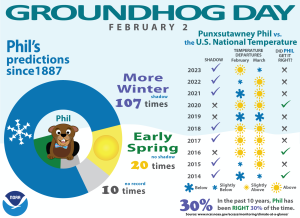
Today is Groundhog Day. Around 7:00 a.m. this morning all eyes were on Gobbler’s Knob, Pennsylvania as handlers of a groundhog named Punxsutawney Phil pulled him from his den to see if the famous groundhog would see his own shadow. He did not, thus predicting six more weeks of winter and an early spring. The annual event, held every February 2nd, in Gobbler’s Knob, brings over 30,000 people to the small town of 5,700 to celebrate and take part in the festivities.
Some may dismiss Punxsutawney Phil’s weather predictions in place of what they call more accurate predictors. But many embrace this silly tradition and joyfully embrace Phil’s annual emergence from hibernation with celebrations and festivities. Phil has been making his prediction in Pennsylvania since 1887.
So, how did all this Groundhog Day business get started? It’s part of a tradition rooted in European agricultural life, marking the midpoint between the shortest day of the year on the winter solstice and the spring equinox. According to Pennsylvania’s tourism website, the origins of Groundhog Day can be traced back to the early holiday of Candlemas, which falls on February 2nd. On this day, Christians bring their candles to church and have them blessed. They believe that clear skies indicate a long winter. Roman legions brought the Candlemas tradition to the Germanic tribes who decided that if the sun appeared on on Candlemas Day and a hedgehog cast a shadow, there would be six more weeks of bad weather to come. These German immigrants then brought their traditions to Pennsylvania in the 18th and 19th centuries. Don Yoder, a University of Pennsylvania professor, found references to February groundhog weather forecasts, used by families of German descent, in a diary dating back to 1841. Punxsutawney is an area where Pennsylvania Germans settled — and in the late 1800s, they started celebrating the holiday by picnicking, hunting, and eating groundhogs. Yes, they are edible, and many claim they taste just like beef!
The groundhog is a member of the squir rel family and is related to chipmunks and prairie dogs. Groundhogs are mammals, spending much of their days foraging for plants and grasses, and digging burrows up to 66 feet long. Groundhogs are only found in North America. Groundhogs are mostly solitary creatures who begin to emerge in midwinter to find a mate. The science behind whether they can make any accurate weather predictions is controversial at best. Phil predicts more winter far more often than he predicts an early spring. Among those who doubt Phil’s predictions is the National Centers for Environmental Information. The government agency last year compared Phil’s record with U.S. national temperatures over the past ten years and came to the conclusion that he was right only 30-40% of the time.
rel family and is related to chipmunks and prairie dogs. Groundhogs are mammals, spending much of their days foraging for plants and grasses, and digging burrows up to 66 feet long. Groundhogs are only found in North America. Groundhogs are mostly solitary creatures who begin to emerge in midwinter to find a mate. The science behind whether they can make any accurate weather predictions is controversial at best. Phil predicts more winter far more often than he predicts an early spring. Among those who doubt Phil’s predictions is the National Centers for Environmental Information. The government agency last year compared Phil’s record with U.S. national temperatures over the past ten years and came to the conclusion that he was right only 30-40% of the time.


























